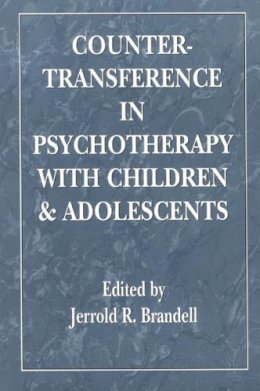
Stock image for illustration purposes only - book cover, edition or condition may vary.
Countertransference in Psychotherapy with Children and Adolescents
Jerrold R. . Ed(S): Brandell
€ 113.74
FREE Delivery in Ireland
Description for Countertransference in Psychotherapy with Children and Adolescents
paperback. Countertransference was believed at one time to consist of the subjective reactions of the therapist whose own unresolved conflicts had been reactivated by the patient's transference. Editor(s): Brandell, Jerrold R. Num Pages: 200 pages. BIC Classification: MMJT. Category: (G) General (US: Trade). Dimension: 228 x 160 x 30. Weight in Grams: 558.
Countertransference was believed at one time to consist of the subjective reactions of the therapist whose own unresolved conflicts had been reactivated by the patient's transference. More recently, however, it has been recast to include the totality of the therapist's attitudes, fantasies, and emotional reactions to the patient. While this important topic has received increased attention in the mental health literature in recent years, little attention has been paid to countertransference encountered in child and adolescent psychotherapy. This book focuses on countertransference in the psychotherapy of children and adolescents in detail. It offers the child and adolescent therapist an invaluable opportunity to explore countertransference in substantial depth and in a variety of clinical encounters across the wide spectrum of child and adolescent psychopathology. Perhaps most importantly, it normalizes the topic of transference in the psycho-therapy of children and adolescents and, in so doing, highlights the clinician's subjective experience as central to the process of psychotherapy.
Product Details
Format
Paperback
Publication date
1992
Publisher
Jason Aronson, Inc. United States
Number of pages
200
Condition
New
Number of Pages
200
Place of Publication
Northvale NJ, United States
ISBN
9780765702814
SKU
V9780765702814
Shipping Time
Usually ships in 15 to 20 working days
Ref
99-15
About Jerrold R. . Ed(S): Brandell
Jerrold R. Brandell, Ph.D., is associate professor at the Boston University School of Social Work, where he teaches clinical practice in the graduate program and directs the postgraduate certificate program in Advanced Child and Adolescent Psychotherapy. He is also the editor of The Journal of Analytic Social Work.
Reviews for Countertransference in Psychotherapy with Children and Adolescents
In this volume, the patients are children and their families, and a series of chapters, written by excellent and experienced clinicians, describes typical countertransferences in specific treatment situations. The reader will be able to make immediate use, through identification, of the range of internal reactions expressed by these authors, and the subtle insights these reactions provide when further explored. I highly recommend this volume.
Morton Chethik, M.S.W. This is an invaluable book because it covers in depth an area that has needed attention. Beginning with an excellent review of the development of theory about countertransference in general and specifically in relation to children and adolescents, it provides an understanding of the controversies and potentials involved in an active use of countertransference phenomena. A few classic papers are augmented by rich contributions from outstanding psychotherapists and analysts from many disciplines. Dr. Brandel probes the wide range of settings and problems that are in the province of child psychotherapy. These are presented from many viewpoints and enriched by case illustrations, and the result is a book that is a must for anyone of any discipline who works with children, adolescents, or their families.
Florence Lieberman, D.S.W. Creeping in ashamedly through the therapeutic back door a few decades ago, countertransference has fast become an essential tool for therapeutic understanding and a major determinant in treatment, at least in the adult world. Possibly because of this same operation, it has been relatively neglected in child and adolescent therapy where, in my opinion, its presence needs to be even more emphasized and demonstrated. This book is a first in doing just this and even as a first, its wide-ranging coverage opens up new areas of inquiry dealing with different disorders, different treatment situations, and different therapist-patient matchings. It is a book I recommend unreservedly to all therapists of the young who struggle daily to contain the complex of unconscious affects generated in them through their daily work. However, even adult therapists could profit from its perusal.
E. James Anthony
Morton Chethik, M.S.W. This is an invaluable book because it covers in depth an area that has needed attention. Beginning with an excellent review of the development of theory about countertransference in general and specifically in relation to children and adolescents, it provides an understanding of the controversies and potentials involved in an active use of countertransference phenomena. A few classic papers are augmented by rich contributions from outstanding psychotherapists and analysts from many disciplines. Dr. Brandel probes the wide range of settings and problems that are in the province of child psychotherapy. These are presented from many viewpoints and enriched by case illustrations, and the result is a book that is a must for anyone of any discipline who works with children, adolescents, or their families.
Florence Lieberman, D.S.W. Creeping in ashamedly through the therapeutic back door a few decades ago, countertransference has fast become an essential tool for therapeutic understanding and a major determinant in treatment, at least in the adult world. Possibly because of this same operation, it has been relatively neglected in child and adolescent therapy where, in my opinion, its presence needs to be even more emphasized and demonstrated. This book is a first in doing just this and even as a first, its wide-ranging coverage opens up new areas of inquiry dealing with different disorders, different treatment situations, and different therapist-patient matchings. It is a book I recommend unreservedly to all therapists of the young who struggle daily to contain the complex of unconscious affects generated in them through their daily work. However, even adult therapists could profit from its perusal.
E. James Anthony
